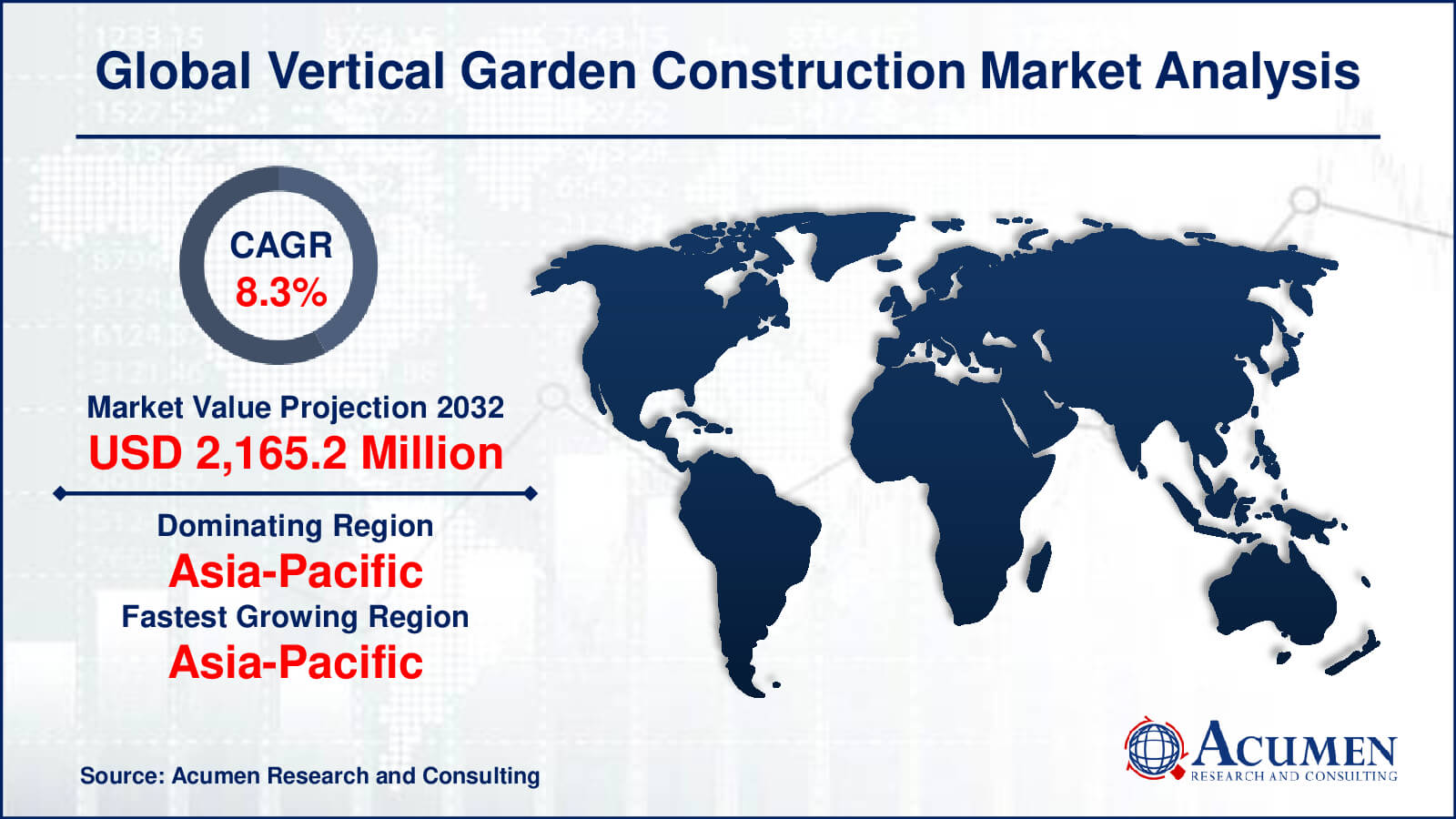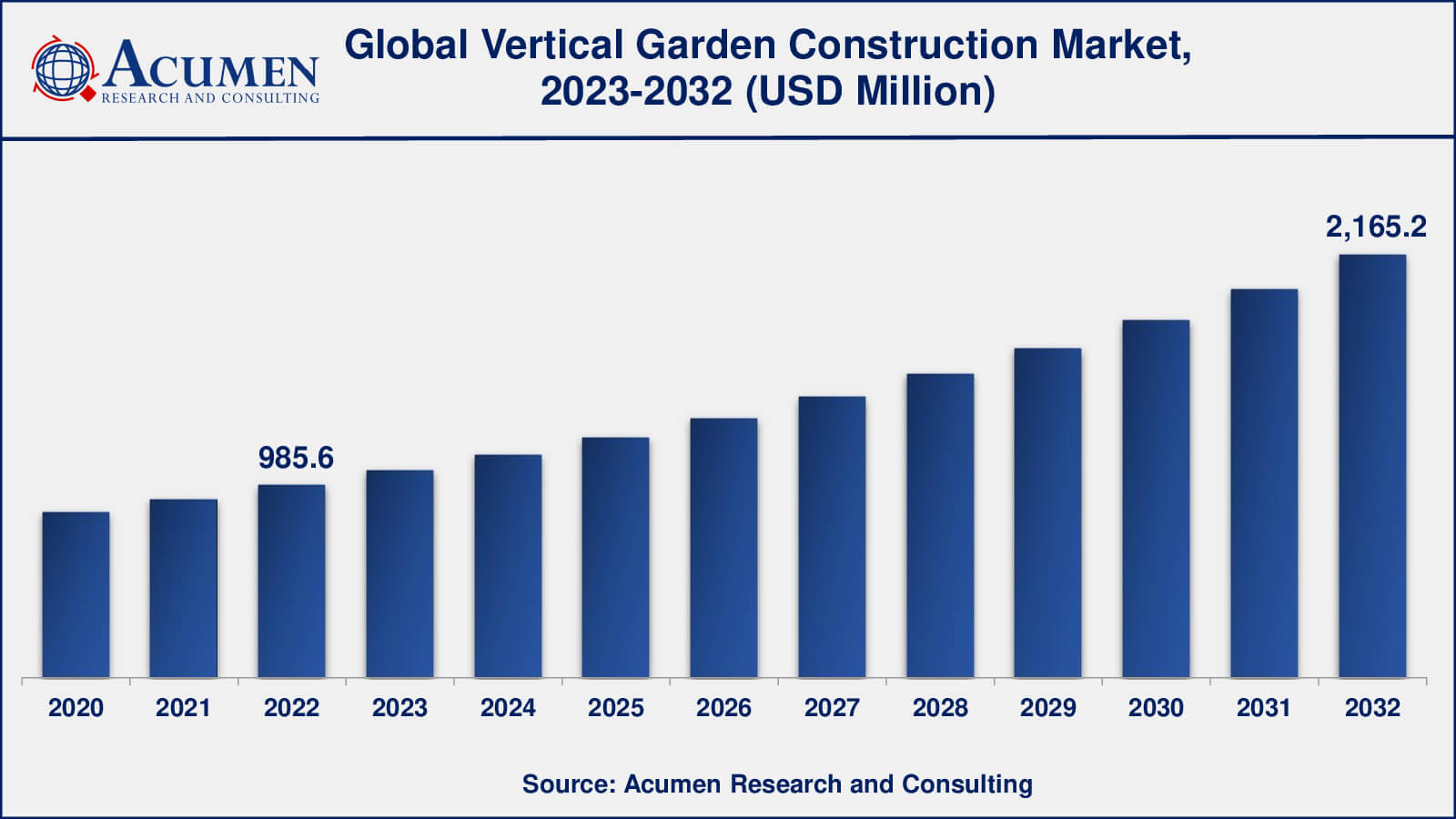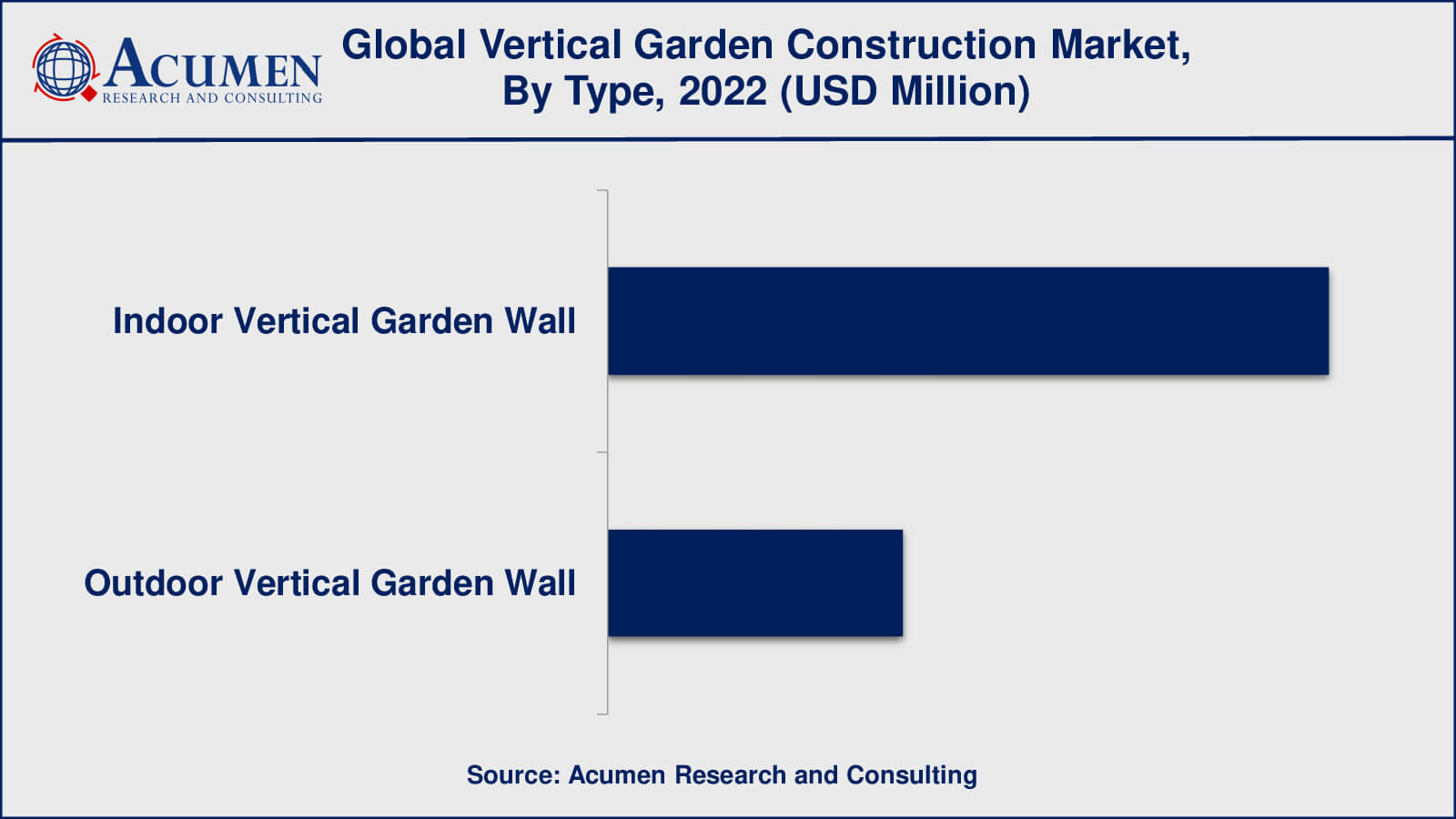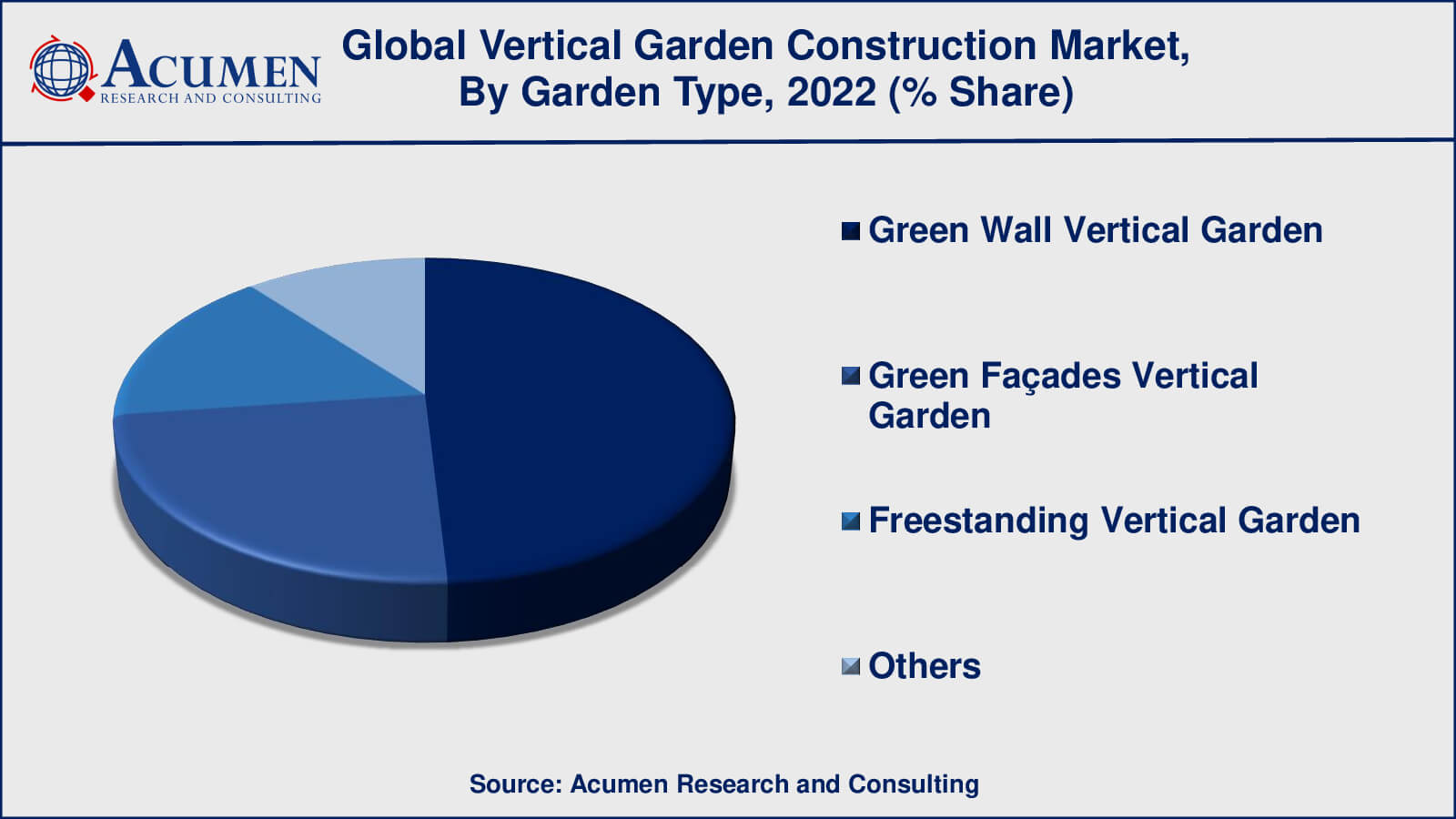Vertical Garden Construction Market | Acumen Research and Consulting
Vertical Garden Construction Market Size - Global Industry, Share, Analysis, Trends and Forecast 2023 - 2032
Published :
Report ID:
Pages :
Format :
The global Vertical Garden Construction Market size was valued at USD 985.6 Million in 2022 and is projected to attain USD 2,165.2 Million by 2032 mounting at a CAGR of 8.3% from 2023 to 2032.
Vertical Garden Construction Market Highlights
- Global vertical garden construction market revenue is poised to garner USD 2,165.2 million by 2032 with a CAGR of 8.3% from 2023 to 2032
- Asia-Pacific vertical garden construction market value occupied around USD 502.6 million in 2022
- Asia-Pacific vertical garden construction market growth will record a CAGR of more than 9% from 2023 to 2032
- Among type, the indoor vertical garden wall sub-segment occupied over US$ 699.7 million revenue in 2022
- Based on garden type, the green wall vertical garden sub-segment gathered around 49% share in 2022
- Expansion of vertical garden construction in emerging markets is a popular vertical garden construction market trend that drives the industry demand

Vertical garden construction refers to the process of creating a garden on vertical surfaces, such as walls or fences, rather than traditional horizontal landscapes. Also known as living walls or green walls, vertical gardens provide a unique and innovative way to incorporate greenery into urban spaces where horizontal land is limited.
The construction of a vertical garden involves several key steps. First, a suitable structure needs to be established to support the weight of the plants and provide a stable framework. This can be done using a variety of materials, including metal frames, mesh panels, or specially designed modular systems.
Vertical garden construction offers numerous benefits. It can enhance the aesthetic appeal of urban areas, improve air quality, reduce the urban heat island effect, and provide insulation to buildings. These living walls also contribute to biodiversity by providing habitat for insects, birds, and other small creatures. Additionally, vertical gardens can help to mitigate noise pollution and create a calming and soothing environment in urban settings.

Global Vertical Garden Construction Market Dynamics
Market Drivers
- Increasing urbanization and limited horizontal land availability
- Growing awareness of environmental benefits and sustainability
- Government initiatives promoting green infrastructure and urban greening
- Advancements in vertical gardening technologies and materials
Market Restraints
- Technical challenges in irrigation and maintenance of vertical gardens
- Limited knowledge and expertise in vertical garden construction
- Potential limitations in plant selection and growth in vertical environments
Market Opportunities
- Increasing demand for vertical gardens in public spaces and commercial buildings
- Adoption of smart technologies for automated irrigation and monitoring systems
- Growing market for vertical garden maintenance services and solutions
- Integration of vertical gardens in sustainable urban development projects
Vertical Garden Construction Market Report Coverage
| Market | Vertical Garden Construction Market |
| Vertical Garden Construction Market Size 2022 | USD 985.6 Million |
| Vertical Garden Construction Market Forecast 2032 | USD 2,165.2 Million |
| Vertical Garden Construction Market CAGR During 2023 - 2032 | 8.3% |
| Vertical Garden Construction Market Analysis Period | 2020 - 2032 |
| Vertical Garden Construction Market Base Year | 2022 |
| Vertical Garden Construction Market Forecast Data | 2023 - 2032 |
| Segments Covered | By Type, By Garden Type, By Application, And By Geography |
| Regional Scope | North America, Europe, Asia Pacific, Latin America, and Middle East & Africa |
| Key Companies Profiled | Atlantis Corporation Australia Pty Ltd, ANS Group Global Ltd., Elmich Pte Ltd, Biotecture Limited, Four Leaf Landscape and Civiltech Pvt Ltd., LiveWall, LLC, Fytogreen Australia, Sempergreen BV, PAISAJISMO URBANO, and ZTC International Landscape Solutions (P) Ltd. |
| Report Coverage |
Market Trends, Drivers, Restraints, Competitive Analysis, Player Profiling, Covid-19 Analysis, Regulation Analysis |
Vertical Garden Construction Market Insights
One of the primary reasons is raising urbanization and the scarcity of horizontal land. As cities become more densely inhabited, there is a greater need for vertical greenery. Vertical gardens provide a solution by allowing individuals to incorporate nature into their surroundings without taking up a lot of space. Another motivator is increased understanding of the environmental advantages and sustainability. By filtering pollutants and creating oxygen, vertical plants help to enhance air quality. They also help to preserve biodiversity by providing habitat for insects, birds, and other creatures. Vertical garden development is becoming increasingly popular as people and companies become more concerned of their environmental effect.
The industry is also being driven by government programmes encouraging green infrastructure and urban greening. Many governments throughout the world are enacting laws and legislation to promote the inclusion of green spaces in urban areas. These programmes seek to improve the quality of life, lower pollution, and lessen the urban heat island effect. Government assistance gives prospects for the vertical garden building sector to develop. Innovation and market growth are being fueled by advancements in vertical gardening technology and materials. Irrigation technologies, lightweight foundations, and modular planting systems have all advanced significantly, making vertical gardens more realistic and sustainable. These developments make vertical gardens easier to construct and maintain, attracting more consumers and boosting the business.
The growing desire for health and biophilic design in business and residential areas is also driving the vertical garden building industry forward. Nature and green places have been proved in studies to improve human well-being and Typeivity. As a result, there is a growing interest in incorporating green features into interior and outdoor design, such as vertical gardens. This approach opens up possibilities for vertical garden creation in a variety of locations, such as workplaces, hotels, and residential buildings.
While these reasons are driving the vertical garden building industry, there are certain constraints to consider. Some clients may be put off by the high initial expenditures connected with vertical garden building. The building of appropriate structures, irrigation systems, and plant choices may all be costly. Furthermore, technical obstacles in watering and maintenance of vertical gardens can be tough for people and enterprises that lack the necessary skills. Plant selection and growth in vertical situations may also be limited. Because of restricted root area or exposure to wind and sunshine, several plant species may not flourish under vertical settings. This might limit the kind of plants that can be utilized in vertical gardens and necessitates careful planning during the design and building phase.
Concerns about the structural stability and load-bearing capabilities of vertical garden installations may further limit market expansion. Building owners and developers must verify that the buildings can withstand the weight of the plants as well as the extra moisture from irrigation systems. To solve these challenges and assure the safety and longevity of vertical gardens, structural analyses and engineering skills are required. Despite these limitations, the vertical garden construction sector offers several options. The increased demand for vertical gardens in public places and commercial structures like shopping malls and airports creates a developing market for vertical garden development. There is also the possibility of incorporating smart technology like as automatic watering and monitoring systems, which would improve the efficiency and practicality of vertical gardens.
Vertical Garden Construction Market Segmentation
The worldwide market for vertical garden construction is split based on type, garden type, Application, and geography.
Vertical Garden Construction Types
- Indoor Vertical Garden Wall
- Outdoor Vertical Garden Wall

According to the vertical garden construction industry analysis, the indoor vertical sector will have a sizable market share in 2022. Indoor vertical garden walls are becoming popular in commercial and domestic settings such as workplaces, hotels, retail malls, and houses. They provide a means of bringing nature within, improving aesthetics, and promoting a healthier indoor environment. Indoor vertical gardens are in high demand due to factors such as the increased emphasis on biophilic design, wellness trends, and the necessity to maximise limited indoor space.
Outdoor vertical garden walls are also becoming more popular in a variety of locations, including building facades, public areas, and urban landscapes. They help to green cities, improve air quality, minimise the urban heat island effect, and increase the visual attractiveness of outdoor spaces. The drive to build more sustainable and visually beautiful urban places has spurred the demand for outdoor vertical gardens.
Vertical Garden Construction Garden Types
- Freestanding Vertical Garden
- Green Façades Vertical Garden
- Green Wall Vertical Garden
- Others

In recent years, both green wall vertical gardens and green façade vertical gardens have grown in popularity. Vertical gardens that are built directly on walls, often utilising a framework or modular system, are referred to as green wall vertical gardens. They're ubiquitous in both indoor and outdoor settings, and they're an aesthetically pleasing and space-efficient method to incorporate greenery.
Vertical gardens with green façades, on the other hand, employ climbing plants or vines that grow vertically on the outer walls of buildings. Vertical gardens of this sort have a more natural and organic appearance, with plants clinging to the building's surface and sprouting upwards. Thermal insulation, noise reduction, and environmental sustainability are all advantages of green façades.
Vertical Garden Construction Applications
- Residential
- Commercial
As per the vertical garden construction market forecast, the residential vertical gardens have gained popularity as homeowners seek to incorporate greenery into their living spaces. They provide a means to bring nature within while also improving the beauty of residential homes. Residential vertical gardens may be put in a variety of locations, including balconies, patios, and internal living spaces, allowing homeowners to create a peaceful and green environment.
Commercial vertical gardens are also commonly used in a variety of business contexts. Offices, hotels, retail malls, restaurants, and other public areas are examples. Commercial vertical gardens not only provide aesthetic value but also help to create a more comfortable and appealing environment for customers, staff, and visitors. They are frequently utilised to boost brand image, promote sustainability, and improve overall experience in commercial environments.
Vertical Garden Construction Market Regional Outlook
North America
- U.S.
- Canada
Europe
- U.K.
- Germany
- France
- Spain
- Rest of Europe
Asia-Pacific
- India
- Japan
- China
- Australia
- South Korea
- Rest of Asia-Pacific
Latin America
- Brazil
- Mexico
- Rest of Latin America
The Middle East & Africa
- South Africa
- GCC Countries
- Rest of the Middle East & Africa (ME&A)
Vertical Garden Construction Market Regional Analysis
The Asia-Pacific region dominated the market with over half of the total share in 2022. APAC includes China, Japan, and Australia, has seen an increase in interest in vertical garden development. Rapid urbanization, limited land availability, and growing environmental consciousness have all led to the popularity of vertical gardens. Vertical gardens have been installed in business buildings, hotels, and public places in major Asian cities such as Shanghai, Tokyo, and Singapore.
In North America, particularly in the United States and Canada, the vertical garden construction market has been witnessing steady growth. Vertical gardens are in high demand due to the growing emphasis on sustainable construction practices, urban greening efforts, and biophilic architecture. Vertical garden building has experienced widespread acceptance in major urban areas such as New York City, Los Angeles, and Toronto, in both the residential and commercial sectors.
Europe has been at the forefront of vertical garden development, with nations like Germany, France, and the United Kingdom dominating the industry. Vertical gardens have been integrated into buildings, public spaces, and infrastructure projects in European towns that have embraced the notion of urban greening and green infrastructure. Government laws and incentives supporting sustainability have boosted industry expansion even further.
Vertical Garden Construction Market Players
Some of the top vertical garden construction companies offered in our report include Atlantis Corporation Australia Pty Ltd, ANS Group Global Ltd., Elmich Pte Ltd, Biotecture Limited, Four Leaf Landscape and Civiltech Pvt Ltd., LiveWall, LLC, Fytogreen Australia, Sempergreen BV, PAISAJISMO URBANO, and ZTC International Landscape Solutions (P) Ltd.
Frequently Asked Questions
What was the size of the global vertical garden construction market in 2022?
The size of vertical garden construction market was USD 985.6 Million in 2022.
What is the vertical garden construction market CAGR from 2023 to 2032?
The vertical garden construction market CAGR during the analysis period of 2023 to 2032 is 8.3%.
Which are the key players in the vertical garden construction market?
The key players operating in the global vertical garden construction market are including Atlantis Corporation Australia Pty Ltd, ANS Group Global Ltd., Elmich Pte Ltd, Biotecture Limited, Four Leaf Landscape and Civiltech Pvt Ltd., LiveWall, LLC, Fytogreen Australia, Sempergreen BV, PAISAJISMO URBANO, and ZTC International Landscape Solutions (P) Ltd.
Which region dominated the global vertical garden construction market share?
Asia-Pacific region held the dominating position in vertical garden construction industry during the analysis period of 2023 to 2032.
Which region registered fastest CAGR from 2023 to 2032?
Asia-Pacific region exhibited fastest growing CAGR for market of vertical garden construction during the analysis period of 2023 to 2032.
What are the current trends in the global vertical garden construction industry?
The current trends and dynamics in the vertical garden construction industry include increasing urbanization and limited horizontal land availability, growing awareness of environmental benefits and sustainability, and government initiatives promoting green infrastructure and urban greening.
Which type held the maximum share in 2022?
The indoor vertical garden wall type held the maximum share of the vertical garden construction industry.?



